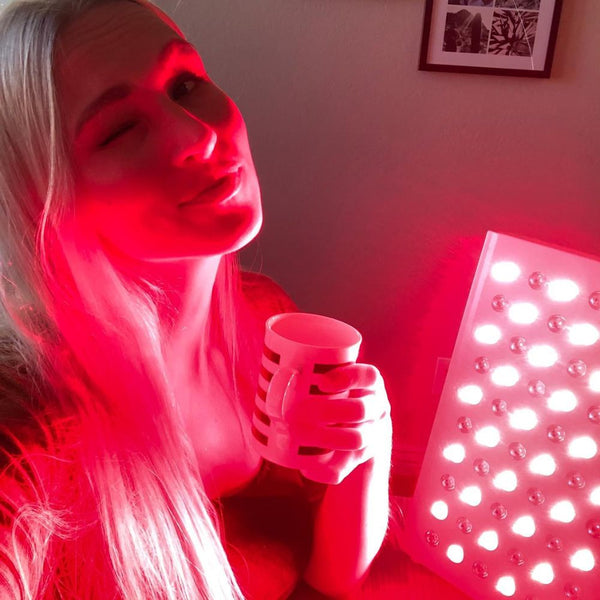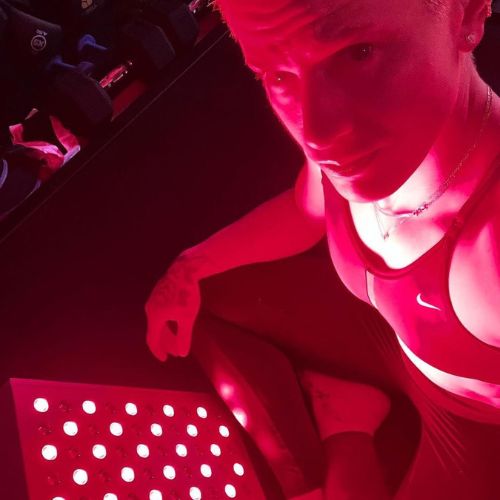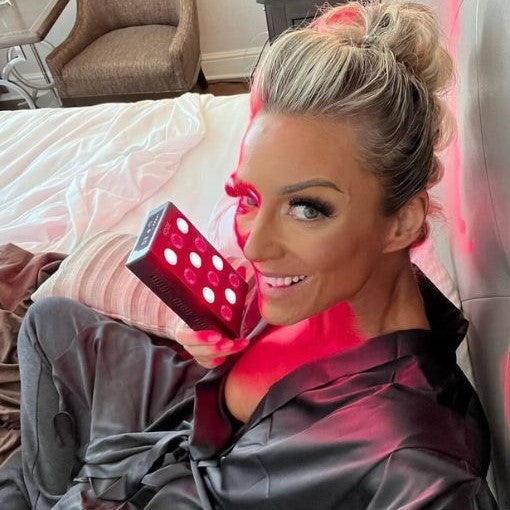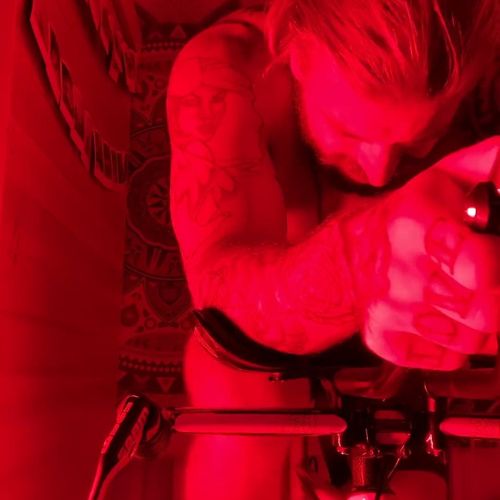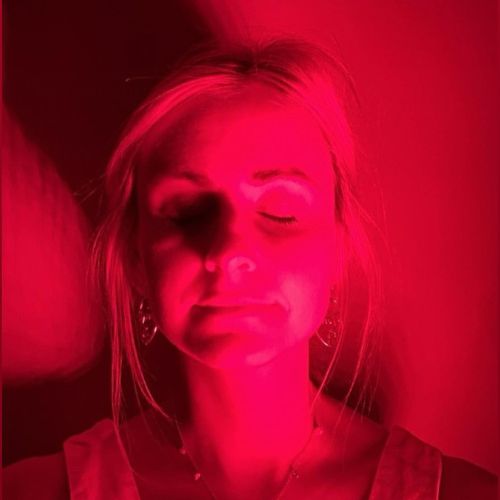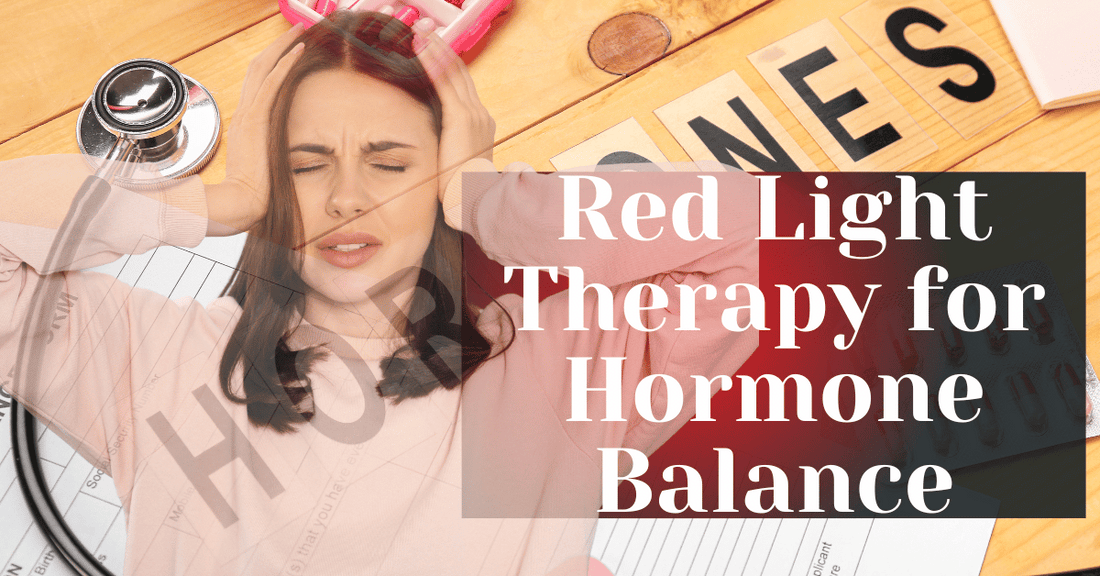
Unlocking Hormone Health: How Red Light Therapy Transforms Wellness
Red Light Therapy for Hormone Balance
Hormones regulate essential body functions, including metabolism, mood, and reproduction. Factors such as stress, diet, and aging can cause hormone imbalances, leading to various health issues. Conventional treatments often involve medication, but red light therapy offers a natural alternative.
Red light therapy (RLT) works at a cellular level to enhance energy production, reduce inflammation, and improve overall wellness. It has been gaining popularity as a non-invasive solution to balance hormones naturally.
What is Red Light Therapy?
Red and near infrared therapy uses specific wavelengths of red and near-infrared light, penetrates the skin and stimulate the mitochondria—the energy centers of cells. By increasing ATP (adenosine triphosphate) production, red light therapy boosts cellular function and reduces inflammation, promoting healing and balance.
Red light therapy involves exposing the skin to specific wavelengths of light using a device that emits both red and near-infrared light.
Applications of red light therapy include skin health, pain relief, wound healing, and, importantly, hormone regulation.
How Does Red Light Therapy Support Hormone Balance?
Red Light Therapy and the Endocrine System
low-level laser therapy positively impacts the endocrine system, which is responsible for regulating hormone production. By stimulating mitochondrial function and increasing ATP (energy) production, RLT helps improve the efficiency of glands such as the thyroid, adrenal glands, and reproductive organs. These glands are responsible for producing hormones that regulate metabolism, stress response, and reproductive health.
How RLT interacts with specific glands:
- Thyroid gland: Red light therapy improves thyroid function, particularly for those with conditions like hypothyroidism.
- Adrenal glands: RLT helps reduce cortisol levels, leading to better stress management and balance in hormone production.
- Reproductive system: RLT supports testosterone and estrogen balance, improving reproductive health in both men and women.
Benefits of Red Light Therapy for Hormone Regulation
Red light therapy offers numerous benefits for hormone balance, including:
- Reduced inflammation: Inflammation is a major cause of hormone disruption. RLT’s ability to lower inflammation helps the endocrine system function better.
- Enhanced mitochondrial health: Improved cellular energy through ATP production supports healthy gland function.
- Better sleep quality: RLT boosts melatonin production, leading to better sleep cycles, which are crucial for regulating hormones like cortisol and growth hormones.
- Lower stress levels: By balancing cortisol, RLT promotes better stress response and overall hormone health.
Table: Key Hormonal Benefits of Red Light Therapy
| Hormonal System | Effect of Red Light Therapy |
|---|---|
| Thyroid Hormones | Improved thyroid function, especially for hypothyroidism |
| Cortisol | Reduced cortisol levels, better stress management |
| Reproductive Hormones | Supports estrogen and testosterone balance |
| Melatonin | Increased melatonin production for better sleep |
Who Can Benefit from Red Light Therapy for Hormonal Balance?
Women Experiencing Hormonal Fluctuations
Women are particularly susceptible to hormone fluctuations throughout their lives, whether due to menstruation, pregnancy, or menopause. Red light therapy has been found to provide relief for women facing the following hormonal challenges:
- Menstrual issues: RLT can help regulate estrogen and progesterone levels, reducing symptoms like cramps, mood swings, and irregular cycles. Estrogen is a hormone that is essential for female reproductive health.
- Pregnancy-related hormone changes: Although pregnant women should consult their healthcare provider before starting any new therapy, RLT has been shown to help with postpartum hormone regulation.
- Menopause: RLT can alleviate symptoms such as hot flashes, fatigue, and mood swings by supporting estrogen balance.
Men with Testosterone Imbalances
Men dealing with low testosterone levels—whether due to aging or lifestyle factors—can benefit from red light therapy. By promoting healthy Leydig cell function in the testes, light therapy enhances testosterone production naturally, leading to:
- Improved energy levels
- Enhanced muscle mass and strength
- Better libido and sexual function
Studies suggest that men using red light therapy near the lower abdominal area or testicular region report improvements in their testosterone levels and overall well-being.
People with Chronic Stress or Adrenal Fatigue
Chronic stress is one of the leading causes of hormonal imbalances, particularly in the production of cortisol. High cortisol levels can lead to adrenal fatigue, which manifests as constant fatigue, poor stress response, and weight gain. Red light therapy can help by:
- Regulating cortisol production
- Reducing inflammation caused by stress
- Supporting the adrenal glands to function more efficiently
Those suffering from chronic stress or adrenal fatigue may find that regular RLT sessions improve both their hormone balance and overall energy levels.
Individuals with Thyroid Disorders
Those with thyroid issues, such as hypothyroidism or hyperthyroidism, are ideal candidates for red light therapy. Studies have shown that RLT can:
- Stimulate the thyroid gland to produce more or fewer hormones as needed
- Improve the efficiency of thyroid hormone regulation
- Alleviate symptoms like fatigue, weight changes, and brain fog
For individuals with hypothyroidism, in particular, red light therapy may reduce the need for hormone replacement therapy by supporting natural thyroid function.
Table: Who Benefits Most from Red Light Therapy for Hormone Balance?
| Group | Key Benefits of Red Light Therapy |
|---|---|
| Women (Menstruation, Pregnancy, Menopause) | Regulates estrogen and progesterone; alleviates menopause symptoms |
| Men (Testosterone Imbalance) | Increases natural testosterone production |
| People with Chronic Stress | Lowers cortisol levels; supports adrenal health |
| Individuals with Thyroid Disorders | Improves thyroid function; balances T3 and T4 hormones |
Understanding Hormone Imbalance
What are Hormones and Their Role in the Body?
Hormones are chemical messengers produced by glands in the endocrine system. They regulate various bodily functions, including metabolism, growth, reproduction, and mood. Hormones such as insulin, cortisol, estrogen, testosterone, and thyroid hormones play vital roles in maintaining balance and overall health.
Key functions of hormones include:
- Metabolism regulation: Controlling how your body uses energy.
- Growth and development: Hormones like growth hormone influence physical development.
- Reproductive health: Estrogen and testosterone regulate sexual function and fertility.
- Mood regulation: Serotonin and cortisol impact emotional stability.
When hormones are balanced, they help keep the body functioning optimally. However, when they become imbalanced, it can lead to various health issues.
Common Causes of Hormone Imbalance
Hormone imbalances occur when there’s too much or too little of a particular hormone in the bloodstream. Here are some common causes:
- Chronic stress: Leads to an overproduction of cortisol, which can disrupt other hormones.
- Poor diet: Nutrient deficiencies and excessive sugar intake can interfere with hormone production.
- Aging: Hormone levels, especially estrogen, progesterone, and testosterone, naturally decline with age.
- Environmental toxins: Exposure to chemicals like endocrine disruptors can affect hormone levels.
- Sleep disorders: Inadequate sleep disrupts the production of hormones like melatonin and cortisol.
- Thyroid dysfunction: Conditions like hypothyroidism and hyperthyroidism can lead to significant hormonal imbalances.
Symptoms of Hormone Imbalance
Hormone imbalances can manifest in various physical, emotional, and cognitive symptoms. Some common symptoms include:
- Fatigue: Feeling tired despite adequate rest.
- Weight gain or loss: Unexplained changes in weight, particularly around the abdomen.
- Mood swings: Irritability, anxiety, or depression.
- Sleep disturbances: Trouble falling asleep or staying asleep.
- Skin issues: Acne, dryness, or excessive oil production.
- Low libido: Reduced sexual drive or difficulty with sexual function.
- Digestive problems: Bloating, constipation, or diarrhea.
Hormone imbalances can significantly impact your quality of life, making it essential to identify and address them.
What Conditions Can Red Light Therapy Help With?
Thyroid Disorders (Hypothyroidism, Hyperthyroidism)

Red light therapy has shown promise in treating thyroid disorders, particularly hypothyroidism. Studies suggest that red light therapy can stimulate thyroid hormone production, leading to improved T3 and T4 levels. This can reduce the need for synthetic thyroid hormone replacements for some individuals. By supporting the thyroid gland, RLT helps maintain proper metabolism, energy levels, and mood regulation.
For individuals with hyperthyroidism, red light therapy may help in reducing inflammation in the thyroid gland, thus promoting better gland function without overstimulation.
Adrenal Fatigue and Cortisol Dysregulation

Adrenal fatigue occurs when the adrenal glands are overworked due to chronic stress, leading to cortisol dysregulation. High cortisol levels result in fatigue, sleep disturbances, weight gain, and mood swings. Red light therapy helps to regulate cortisol production by improving sleep quality and reducing overall stress levels.
By targeting the adrenal glands, RLT promotes a more balanced stress response and helps lower cortisol levels, thus alleviating symptoms of adrenal fatigue.
Menopause and Hormonal Changes

For women going through menopause, fluctuating estrogen levels can cause a range of symptoms, such as hot flashes, night sweats, mood swings, and weight gain. Red light therapy has been shown to help regulate estrogen levels, providing relief from these uncomfortable symptoms.
Additionally, by supporting mitochondrial health, RLT can improve energy levels and help combat menopause-related fatigue.
Testosterone Imbalance in Men

Men with low testosterone levels can benefit from red light therapy, which has been shown to stimulate testosterone production naturally. Studies suggest that RLT applied near the testicular area can enhance Leydig cell function, responsible for producing testosterone. Men who have undergone RLT treatments report improved energy, better muscle mass, and enhanced libido.
Table: Conditions Red Light Therapy Can Help With
| Condition | Benefits of Red Light Therapy |
|---|---|
| Hypothyroidism | Improves thyroid hormone production, reduces medication dependency |
| Adrenal Fatigue | Lowers cortisol, supports balanced stress response |
| Menopause | Regulates estrogen, alleviates menopause symptoms |
| Low Testosterone in Men | Stimulates natural testosterone production |
How to Use Red Light Therapy for Hormone Balance
Frequency and Duration of Sessions
For optimal results, the recommended frequency for red light therapy sessions is typically 3 to 5 times per week, with each session lasting between 10 to 20 minutes. However, the exact protocol can vary based on the specific condition being treated and the device being used. Hormonal imbalances may require several weeks of consistent therapy before noticeable improvements are observed.
Some general guidelines for using red light therapy for hormone balance include:
- Initial phase: Daily or every other day sessions for the first 4-6 weeks.
- Maintenance phase: 1-3 sessions per week once improvements are noticed.
Consistency is key, and it’s important to give the body time to respond to the treatment.
At-Home Devices vs. Professional Treatments
At-home red light therapy devices have become increasingly accessible and effective for personal use. These devices range from small handheld units to larger panels that can cover broader areas of the body. Some common types of devices include:
- Red light therapy panels: Ideal for full-body treatments and targeting large areas like the thyroid or adrenal glands.
- Handheld devices: Useful for focusing on specific areas, such as the face or joints.
For those seeking professional treatments, clinics and wellness centers often offer more powerful red light therapy machines that provide stronger doses in shorter periods of time.
| Device Type | Best for | Duration |
|---|---|---|
| At-home panels | Full-body or targeted treatments | 10-20 minutes |
| Handheld devices | Smaller, targeted areas (e.g., thyroid, adrenal) | 5-10 minutes |
| Professional clinic machines | Quick, high-powered treatments for hormone balance | 5-10 minutes |
Safety and Side Effects
One of the reasons for the popularity of red light therapy is its safety profile. Most individuals experience no side effects, and the treatment is non-invasive. However, a few precautions should be kept in mind:
- Eye protection: Avoid staring directly at the light source to prevent potential eye discomfort.
- Skin sensitivity: Some individuals may experience mild skin irritation or dryness after prolonged exposure.
Overall, RLT is considered safe for daily use, but if you have any existing health conditions or are pregnant, it’s best to consult with a healthcare professional before starting.
Combining Red Light Therapy with Other Hormone Balance Strategies
While red light therapy can significantly improve hormone balance, it’s most effective when combined with other lifestyle adjustments. Consider integrating the following strategies into your wellness routine:
- Healthy diet: Focus on whole foods rich in antioxidants, omega-3s, and essential vitamins.
- Regular exercise: Physical activity helps to naturally regulate hormones like cortisol and insulin.
- Stress management: Techniques such as meditation, yoga, or deep breathing can further reduce cortisol levels.
- Adequate sleep patterns: Prioritize 7-9 hours of sleep per night to support the natural production of hormones like melatonin and growth hormone.
Frequently Asked Questions About Red Light Therapy for Hormone Balance
1. Is Red Light Therapy Scientifically Proven to Balance Hormones?
Yes, scientific studies support the use of red light therapy for improving hormone balance, particularly in cases related to thyroid health, cortisol regulation, and testosterone levels. Several studies have demonstrated how RLT positively impacts the endocrine system by enhancing mitochondrial function, which directly influences hormone production and regulation.
For example, a study published in Lasers in Surgery and Medicine showed that patients with hypothyroidism experienced improved thyroid function after undergoing red light therapy. Additionally, research has found that red light therapy can reduce cortisol levels, leading to improved stress management and balanced hormones.
2. How Long Does It Take for Red Light Therapy to Work for Hormone Balance?
While individual results can vary, most users begin to notice improvements within 4-6 weeks of regular red light therapy sessions. The first signs of change often include better sleep quality, reduced stress levels, and increased energy. For more severe hormone imbalances, it may take 2-3 months before more significant changes, such as regulated thyroid function or reduced menopausal symptoms, become apparent.
The key is consistency—using red light therapy multiple times a week for the recommended duration is essential for achieving the desired results.
3. Can Red Light Therapy Replace Medication for Hormone Imbalance?
While red light therapy can significantly improve hormone regulation, it should not be viewed as a replacement for medication in severe cases of hormone imbalance. For conditions like hypothyroidism, menopause, or adrenal fatigue, red light therapy can be an effective complementary treatment to reduce symptoms and support overall wellness.
However, it's essential to consult with a healthcare professional before reducing or discontinuing any medication. Red light therapy is most beneficial when combined with lifestyle changes, medications, and other treatments, as advised by a doctor.
4. Are There Any Risks to Using Red Light Therapy for Hormone Balance?
Red light therapy is generally considered safe and well-tolerated. It is a non-invasive and non-thermal treatment, meaning it doesn’t involve harmful heat or radiation. However, there are a few precautions to keep in mind:
- Eye protection: Avoid looking directly into the light source, as prolonged exposure to the bright light may cause eye discomfort.
- Skin sensitivity: Some individuals with sensitive skin may experience mild irritation or redness after using red light therapy.
As with any therapy, if you have underlying health conditions or are pregnant, consult your healthcare provider before starting red light therapy.
5. Can I Use Red Light Therapy Alongside Other Treatments for Hormone Balance?
Absolutely! Red light therapy works well when combined with other treatments for hormone balance, such as:
- Hormone replacement therapy (HRT)
- Dietary changes to support hormonal health (e.g., reducing sugar intake, adding omega-3 fatty acids)
- Stress management techniques like meditation or yoga
- Supplements such as vitamin D, magnesium, and adaptogens
By integrating red light therapy into a holistic approach to hormone balance, you can improve the overall effectiveness of your treatment plan.
Conclusion
Red light therapy is an increasingly popular, non-invasive approach for supporting hormone balance and addressing a variety of hormonal issues. By enhancing mitochondrial function, reducing inflammation, and supporting the natural function of key glands like the thyroid, adrenals, and reproductive organs, RLT can help individuals experience relief from hormone-related symptoms such as fatigue, stress, mood swings, and weight changes.
Though not a replacement for traditional medical treatments, red light therapy offers a complementary solution that can work alongside medications, lifestyle changes, and other wellness practices. Whether you’re dealing with menopause symptoms, testosterone imbalance, thyroid disorders, or chronic stress, red light therapy can provide noticeable improvements in energy levels, sleep quality, and emotional stability.
Consistency and patience are key to experiencing the full benefits of red light therapy. Over time, RLT can help you achieve a more balanced and harmonious hormonal state, improving both your physical and mental well-being.
